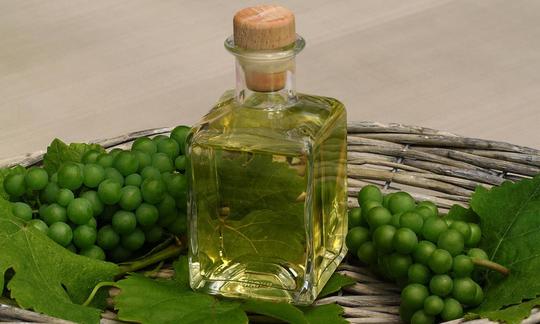Grape seed oil ( grape seed oil Grape seed oil (or grape seed oil) is a vegetable oil obtained from the seeds of grapes ( Vitis vinifera ssp. vinifera). It is a byproduct of wine production. The high content of linoleic acid is particularly problematic for health.
Use in the kitchen:
There are two variants of this cooking oil. You can either buy cold-pressed grape seed oil or hot-pressed one.
A hot-pressed cooking oil is obtained through a multi-stage refining process at high temperatures (this, together with the pressing pressure, creates temperatures of over 100 °C). Refined grape seed oil has a neutral color and a neutral taste. 1 It can also be heated to very high temperatures (smoke point at 200 °C) and is therefore ideal for frying. 2 However, valuable unsaturated fatty acids, secondary plant substances and proteins are lost during the refining process. 3 Unsaturated fatty acids are converted into trans fats.
Cold-pressed oil from grape seeds is more natural (native), more aromatic and has a light green shimmering or green-golden yellow color. Its taste is slightly nutty and varies depending on the grape variety. Cold-pressed oil is well suited for cold use, e.g. for seasoning salads and sauces, or goes well with cheese. Cold-pressed seed oil also has a relatively high smoke point. 2 Because of the high linoleic acid content in grape seed oil, we recommend replacing it with rapeseed oil, which contains significantly less linoleic acid.
| Not only vegans or vegetarians should read this: Vegans often eat unhealthily. Avoidable nutritional errors. |
Purchasing:
You can buy cold-pressed grape seed oil mainly in organic stores or in numerous online shops.
Cold-pressed oils (laws, raw food)
In Switzerland, oil is referred to as cold-pressed oil if the oilseed was not heated, the pressing temperature did not exceed 50 °C and no problematic post-treatment took place.
According to the Federal Department of Home Affairs ( FDHA), an edible oil is considered to be cold-pressed (or may be described with synonyms such as (extra) virgin, unrefined, cold-pressed or natural) if it is obtained by pressing or centrifuging from previously unheated raw materials, the temperature during pressing did not exceed 50 °C and there was no refining, i.e. no neutralisation, no treatment with adsorbents, bleaching earth and no steaming.
An oil may be described as “gently steamed” if the refining process was limited exclusively to steaming and the temperature did not exceed 130 °C 14.
In the EU and the USA, there does not appear to be a generally applicable temperature limit for cold-pressed oils. For example, the guidelines for edible fats and oils of the Federal Ministry of Food and Agriculture (D) are similar to the EDI regulation, but they do not specify a permissible maximum temperature for general cold pressing - since they only apply to products whose labelling and composition are not conclusively defined by law (i.e. not for olive oil, cocoa butter, milk fats, spreadable fats, for example). 15
However, both the EU directives and the amendment to the EDI regulation on edible oil provide for special rules for the labelling of olive oils. 16,17
These are selective marketing rules in which the term raw food is not defined. "Raw food" and "raw" are therefore not state-protected terms (as is the case with the term "organic"), which leaves a lot of room for interpretation. Although it is agreed that with purely mechanical cold pressing, the pressing temperatures generally do not exceed 40 °C, one should not naively assume that cooking oils are raw food quality. There is a suspicion that the measuring method used does not indicate the temperature in the press cylinder (where the heat is highest), but only the outlet temperature in the oil hose. With water-cooled olive oil presses (so-called "water-cooled 37°" oil presses), one probably cannot even say with certainty what the exact temperature is inside the press cylinder, because the entire press cylinder is surrounded by cooling sleeves.
In addition, the pressing pressure and speed as well as the moisture content of the oilseed affect the pressing temperature. If, for example, the moisture content is too low, the temperature rises during pressing and it is difficult to stay even below the maximum limit of 50 °C. 18
Storage:
Cold-pressed oils generally have a shorter shelf life than refined ones. Since grape seed oil has a particularly high proportion of unsaturated fatty acids, it should be protected from heat, light and oxygen during storage. Due to its high vitamin A content, this seed oil is more resistant to oxidation and therefore tastes less rancid. For this reason, it is also more durable than normal oils and can be stored for up to 18 months. Please ensure that the bottle is always tightly closed and that the oil is kept in the dark. Grape seed oil does not belong in the refrigerator. 4
Ingredients:
Grape seed oil is actually a very rich oil with lots of vitamin E and is extremely rich in essential fatty acids. Unfortunately, these only contain a minimal amount of omega-3 fatty acids, but around 69% linoleic acid, an omega-6 fatty acid. Increased consumption of omega-6 fatty acids can promote inflammatory processes and increase the risk of strokes if the ratio to omega-3 is not right. Because grape seed oil contains a particularly high amount of linoleic acid and a particularly low amount of alpha-linolenic acid, it contributes greatly to this imbalance. 5
The complete ingredients, the coverage of the daily requirement and comparison values with other ingredients can be found in our nutrient tables. In the article Nutrients explained you will get a detailed insight into the topic. CLICK FOR before the text.
Health aspects:
This kernel oil has a strong antioxidant effect, particularly thanks to vitamin E and procyanidin 6. 12 It therefore reduces cell damage and arteriosclerosis. It is also considered to be anti-inflammatory and anti-cancer, 11 antimicrobial and neuroprotective. 7 The oil lowers cholesterol levels, can help with metabolic disorders and is useful in the treatment of skin diseases such as neurodermatitis, acne and psoriasis. The lecithin it contains improves cognitive performance and has a positive effect on blood count. 6
Linoleic acid also performs important functions in our body, provided that it is consumed in moderation and that the LA:ALA ratio is correct by giving greater consideration to foods with a high content of natural alpha-linolenic acid (ALA) over linoleic acid (LA).
Dangers/Intolerances:
Depending on the type of oil, the fatty acid esters 3-MCPD and glycidol are produced during the refining of oils and are classified as harmful to health. 3 Therefore, if possible, avoid buying refined grape seed oil.
In the early 1980s, grape seed oil made headlines because samples containing high concentrations of polycyclic aromatic hydrocarbons were found, probably from fumes produced during the drying process. 1
Use as a medicinal plant:
Grape seed extract (or OCP = oligomeric proanthocyanidins) is extracted from ground grape seed shells. It is available as an antioxidant in the form of capsules. Consuming large amounts is said to inhibit the growth of colon, stomach, breast and prostate cancer. It is also said to protect against liver damage during chemotherapy and prevent cardiovascular diseases.
Scientists from India found in a study that OPC has a similar effect in combating diabetes as the drug "Metform...". Grape seed extract is also said to stabilize insulin levels. The same capsules are also said to reduce hair loss (promoting blood circulation in the scalp) and have many other benefits. 9
Because most studies work with very few subjects, there are doubts about their scientific validity and thus about the proven effect of the extract. 10 It is not recommended to take it at the same time as dairy products, as the protein contained in them is said to reduce the antioxidant effect of the OPC. 13
Occurrence:
The cultivated vine ( Vitis vinifera) is a widespread cultivated plant and is used to produce wine grapes. It grows in vineyards, vineyards, on walls, houses, mostly on dry soil in sunny locations - from the plains to the Himalayan mountains. As a remnant of former cultures, it can be found in floodplains, on banks, forest edges, sunken roads and in bushes. The wild vine ( Vitis silvestris) is threatened with extinction in Central Europe. In the Mediterranean region, however, in central France, southwestern Switzerland, the Upper Rhine Plain, in the river basins of the Danube, in southern Russia and in Asia Minor, the wild variant is quite widespread.
General information:
Grape seeds contain between 8 and 20% oil (when dried), with Bordeaux grapes being the best. 12 Although oil extraction from grape seeds only became popular with wine production, grape seed oil was on many menus in the Middle Ages. 6
The residue from cold pressing grape seeds is often processed into grape seed flour. This is then used to make baking mixes for bread or pasta. Because grape seed flour retains its valuable ingredients even when heated to high temperatures, it can be used for baking, but only in proportion (5 to 10%) to conventional flour. It gives all baked goods a hearty, nutty taste. 13
Grapeseed oil is occasionally mixed into margarines.
The cosmetics industry has discovered a substance in grape seed oil that is easily absorbed into the skin without leaving a greasy film. It is said to have a regenerative and moisturizing effect. The procyanidin it contains makes the skin elastic. Phytosterols have been a popular ingredient in cosmetic products for several years, as they protect sensitive skin from UV radiation with a skin-lipid barrier. The oil is used in soaps, varnishes, paints, spray paints and, to a limited extent, in linoleum. 6
Literature - Sources:
Bibliography - 17 Sources
| 1. | Wikipedia Traubenkernöl. |
| 2. | Öl-kontor.de Übersicht der Rauchpunkte & Brennwerte von Öl. |
| 3. | Infothek-gesundheit.de Öl ist nicht gleich Öl – Herstellung und Qualität von Speiseöl. |
| 4. | Öl-kontor.de Traubenkernöl. |
| 5. | Wissen-olivenoel.de Linolsäure. |
| 6. | Krist S. et al. Lexikon der pflanzlichen Fette und Öle. Wien: Springer Verlag; 2008: 464-470. |
| 7. | Journals.sagepub.com Grape Seed Oil Compounds: Biological and Chemical Actions for Health. |
| 9. | opc-traubenkernextrakt.com/ |
| 10. | natur-kompendium.com /opc-traubenkernextrakt/ |
| 11. | www.sciencedirect.com /science/article/pii /S0308814611004213? via%3Dihub |
| 12. | www.ncbi.nlm.nih.gov /pmc/articles /PMC4988453/ |
| 13. | Wikipedia Traubenkernmehl. |
| 14. | Verordnung des EDI über Speiseöl, Speisefett und daraus hergestellte Erzeugnisse vom 23. November 2005 (Stand am 1. April 2008), Art. 3a und 3b. |
| 15. | bmel.de Leitsätze für Speisefette und Speiseöle. Neufassung vom 02.07.2020 (BAnz AT 18.08.2020 B3, GMBl 2020 S. 530). |
| 16. | Amtsblatt der Europäischen Union. Durchführungsverordnung (EU) Nr. 29/2012 der Kommission vom 13. Januar 2012 mit Vermarktungsvorschriften für Olivenöl. Artikel 5 a) und b). 14.1.2012. |
| 17. | Verordnung des EDI über Speiseöl, Speisefett und daraus hergestellte Erzeugnisse. Änderung vom 25. November 2013. Art. 2b. |
| 18. | Schaufler D. Oilseed Fact Sheet: Oilseed Presses. Dept. of Agricultural and Biological Engineering, Penn State College of Agricultural Sciences. |









Comments